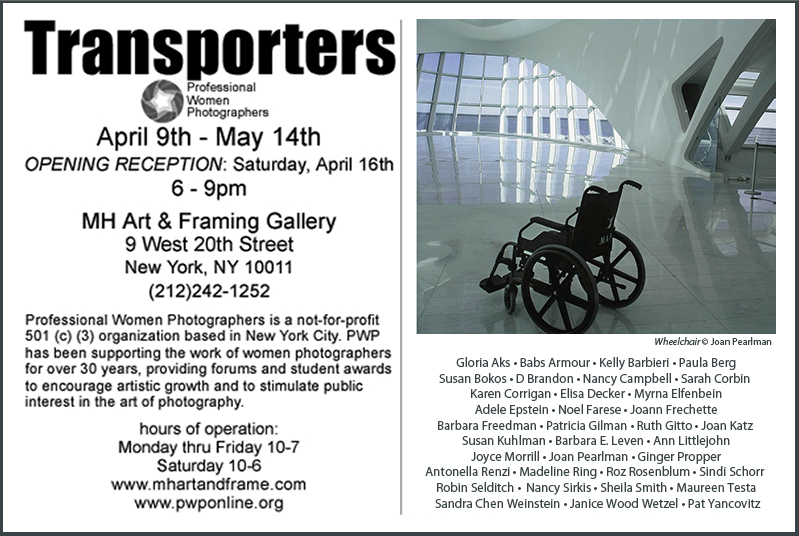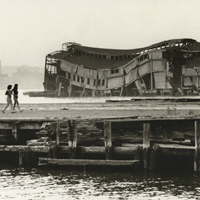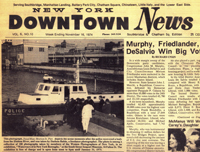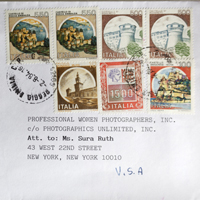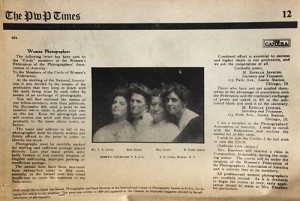Tag Archives: Professional Women Photographers Archives
Out There in the Fields…
Out There in the Fields…
He came down from the Bronx in a block of ice. Nobody saw him for a while because there was a cold snap on and it wasn’t over yet. The weeks from the holiday season through mid-January 1973 had been raw and unforgiving.
But on Wednesday, January 17th, the weather began to improve. Darleen Rubin, a freelance photographer (The Villager, W, and Women’s Wear Daily), was scheduled to do headshots for an actress. She began the shoot out on the balcony of her Christopher Street apartment, but as the sun brightened, decided to go down to a favorite spot by the river where the light was soft and flattering. It was shaping up to be a beautiful day.
Rubin has an eye for beautiful things. She has photographed the clothes of Carolina Herrera, Calvin Klein and Michael Vollbrecht, and taken pictures of Jacqueline Kennedy Onassis visiting the Met. A long-time New Yorker, she never went off to distant lands to cover disaster and war. But that day a war of sorts found its way to her on the watery edge of the West Village.
She and her client stepped out, happily planning the next set of pictures. But as they neared the river, they saw a knot of people gathered on the Morton Street Pier, staring down. They walked over and saw what appeared to be a thatch of hair poking out of the murk.
At first Rubin thought someone had fallen in and was unconscious. “I kept waiting for him to wake up, to move.€ She watched for a while, but he didn’t move and he certainly didn’t wake up.
When she realized the man was dead, she felt sick. But she also said to herself “I am a photographer…I have to photograph what I see and remain unemotional; do the job; get the picture and do it as best I can.€
The Harbor Police were the first to appear on the scene, and as they moved in with grappling hooks, she raised her camera and began to shoot. It was then that she realized there was more, that it wasn’t just a head, but an entire body. “Fish had eaten parts. . . it was horrible to look upon. “
But she went on. “I had to ignore my emotions, and just shoot it,€ she said. “I watched and photographed as the policemen and the Medical Examiner were discussing the situation and completing forms. They were all somber; no joking around. A solemn assembly taking care of business in a professional manner.€
A professional herself, Rubin went about her own work, photographing the scene in 35 millimeter and 2¼ formats, in color and black and white. Then she picked up where she left off. Photographing the model, she said, “pulled me back to the living.€
Initially the victim, a Queens College student, was thought to be part of a series of crimes against gay men that had taken place that January in the Village and Brooklyn, but the police determined that this wasn’t so. There was no evidence of foul play and the circumstances of the man’s death were never discovered.
Officially this blog is about the experience of women in photography from the Seventies on, but another character keeps crowding onto the stage. You can’t talk about New York photography in the 70′s and 80′s without acknowledging the multi-faceted, noirish force of crime, dirt and fear that cast a pall over the city, blotting out its legendary glamour, choking off its dreams. Physically, New York was falling apart. The roads and streets were crumbling, the bridges and piers were buckling, and the Bronx was going up each night in flames. To many, including President Ford, the city was beyond hope and help.
Today it’s a different picture. Landscaped parks stretch for miles along the river, and sleek glass condos poke into the West Village sky. Meat packing is gone and boutiques have moved in. Crime has fallen to record lows, and it is altogether a much safer and better place. Yet sometimes a strange nostalgia creeps in for the drama of that earlier day, and for some, if not all, of the visual grit and dark poetry that went with it.
Note: Darleen’s photographs of January 17, 1973 were exhibited in Waterways of the New York Boroughs (South Street Seaport Museum 1974-75)*, Taking a Different Tack–Maggie Sherwood and the Floating Foundation of Photography (Samuel Dorsky Museum of Art at SUNY New Paltz, 2009, and at the Salmagundi Club show accompanying the Be-hold photo auction in 2010.
*This was an exhibit of Women Photographers of New York, a group founded by Dianora Niccolini, the first president of PWP
- Catherine Kirkpatrick, Archives Director
Cards and Letters: A Snapshot
Cards and Letters: A Snapshot
They came from all over, from Arkansas, Illinois and Italy. Some were handwritten, some were typed. They came on scraps of notebook paper, cheap postcards and fine bond, all with the same request: send info please! I want information on Professional Women Photographers.
“I read about your organization…€
“Didn’t know any group like this existed…€
“Though I have belonged to any number of professional organizations I have never belonged to one that treated women as equals with men photographers…As a creative professional I am especially needful of a supportive group…”
These letters are more than personal requests; they speak of a time and place and a need, sometimes bordering on desperation. You sense the hunger as they ask, are there more women photographers out there like me? How can I reach them? How can I stay in touch?
In the 70′s, when PWP was founded, there was an excitement and energy in the air. Cultural movements that began in the 60′s – desegregation and women’s liberation – were coming to fruition. They weren’t just ideas anymore, they were realities. Colleges were integrating and going co-ed. Women were leaving the kitchen for the corporation, and entering professions that had long been off limits or male-dominated, like photography. There was a spirit of can do and why not? The climate had been set for change and it was happening. If the 70′s lacked the polish of the 50′s and the fervor of the 60′s, they offered real chances as fields previously closed opened up as they never had before or would again until the digital revolution in the 90′s.
But people needed a little help. A lot of small organizations and photo co-ops sprang up - Soho Photo, The Floating Foundation of Photography, Professional Women Photographers. These efforts were grass roots because they had to be – there were very few established organizations for art photographers and women photographers to turn to. It was uncharted territory: a new frontier with a new kind of pioneer.
That time, the 70′s and early 80′s, wasn’t really so long ago. But looking at these letters, many typed on a typewriter with a single courier font, you realize that information wasn’t an easy click away. These women had to go after it. They had to read photo publications, write letters and mail them off. They had to want more for themselves – more options, more opportunities. Joining a women’s photographic group was a huge step for them.
But the hunger and the hope has always been there. To the left is the PWP Times reprint in 1983 of a 1909 article published in The Camera. It details how members of the Women’s Federation of the Photographers’ Association of America kept in touch with each other’s work by exchanging photographs.
These ladies were directed to “send a print to the member whose name is above your own on this list. Keep the photograph you will receive one week and then forward promptly to the name above yours…. The name and address in full of the photographer must be clearly written and firmly affixed to the print in order to identify the work. Photographs must be carefully packed for mailing and sufficient postage placed thereon.”
It took more than a click, but the hunger was there. It has been there for a long, long time. At least since 1909 and probably way before.
- Catherine Kirkpatrick, Archive Chair


